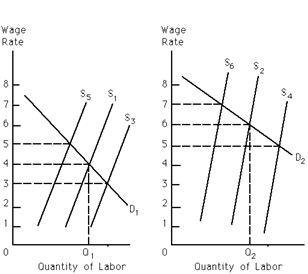Multiple Choice
Exhibit 26-7 
Market A Market B
Refer to Exhibit 26-7. The exhibit shows two markets in which labor of identical skills is employed. Assume that both markets are in equilibrium with Q1 and Q2 quantities of labor employed at the respective prices of $4 and $6 per unit. If this equilibrium persists in the long run, an economist would suspect that
A) nonpecuniary benefits are higher in market A.
B) nonpecuniary benefits are higher in market B.
C) there is discrimination in market A.
D) there is no cost of moving across markets.
Correct Answer:

Verified
Correct Answer:
Verified
Q9: Suppose it has just been discovered that
Q90: If for a firm MRP > MFC,
Q114: Given a 10 percent increase in wages,
Q144: A perfectly competitive firm will maximize its
Q145: A firm will maximize its profits by
Q146: When deciding whether a person is "worth"
Q147: Marginal productivity theory implies that a worker
Q150: Which of the following was not included
Q151: One way to calculate marginal revenue product
Q154: Exhibit 26-1 <img src="https://d2lvgg3v3hfg70.cloudfront.net/TBX9059/.jpg" alt="Exhibit 26-1